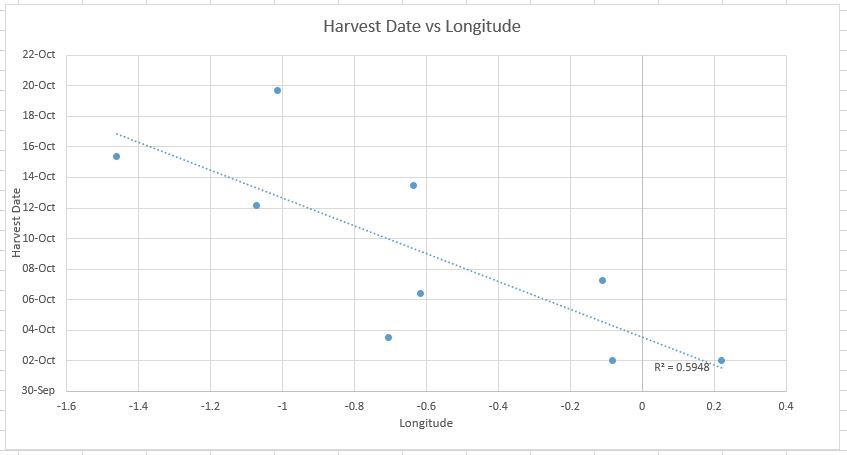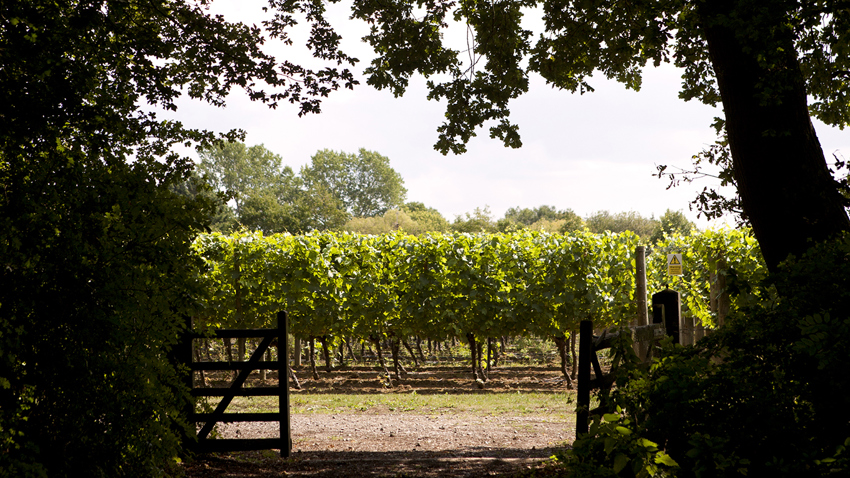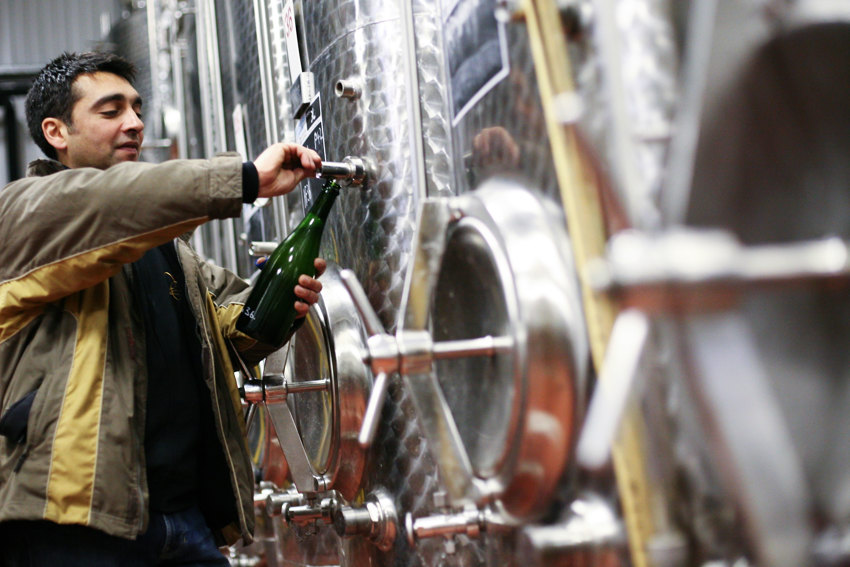24 years of English Winemaking with Ridgeview
England makes ultra-pure sparkling wines with racy acidity, balanced by concentrated, defined fruit character. At its most basic, that’s what I believe marks our wines out from the rest of the world. The result of the long, slow ripening in our unique cool conditions.
Making wine on the margins, in a challenging environment, means that site selection is paramount. Vineyards here have to be perfectly suited to their microclimate to thrive. Over my five years working in English wine, my conviction that this tough environment, where the difference between the success and failure of a vineyard lies on a knife edge, brings a real clarity and specific character to very small plots of land. Each field speaks as clearly and resonates as much as you could wish from any historic fine-wine region. And with a bit more time, this will be even clearer. It is hard to define what the whole county of Sussex’s wines share in common at present, but if you look at Sussex on a site-by-site level, you begin to find consistent characters. There’s proper terroir going on.
Using two decades of experience (and data) to understand English terroir
I am very lucky to have worked with the team at Ridgeview since 2014. Early pioneers of the English sparkling wine movement in the 1990s, the Roberts family’s winery is in Ditchling, East Sussex. They source their fruit from a spread of diverse grower-owned vineyards across the South East of England, as well as their own sites. This gives Ridgeview a keen insight into how the various major growing regions in the UK perform each year, and now their twenty years’ worth of data is starting to show some trends. The family have always talked to me about the wines showing, first and foremost, the character of their vineyards, the aim being to communicate a sense of place.
I want to explore this further.
With all this vineyard data in our hands, I sit down with Vineyard Manager of sixteen years, Matt Strugnell and Winemaker Director Simon Roberts to discuss how Ridgeview use this detailed understanding of each of their vineyards to best effect. What trends can we see in the vineyard? What considerations does Matt make when assessing a site? How does Simon approach his winemaking to best communicate vineyard diversity?
Why Ridgeview harvest from east to west
Matt tells me about an anecdote passed on decades ago, in the pub, by an old Kentish farmer that has always stuck with him. The farmer talked about generations of travelling harvesting teams that irrespective of the fruits they picked, would always start in the east of England and move westwards as the season progressed.
Interestingly, if you look at harvest dates for each of our Ridgeview Vineyards since they were established, they seem to follow this old east to west theory. The data shows that Ridgeview’s vineyards in the east tend to ripen earlier. As you move westwards, the harvesting dates generally move further and further back. Bang on Farmer.
In practical terms, this east to west pattern helps Matt plan which sites will be picked in what order. He knows the typical early ripeners. As each season progresses, he affects his plans to fit the unique progress of each, finally picking each site as it becomes perfectly ripe. We don’t always pick east to west but it’s a good start.

In parallel to the end-of-season ripening data above. It is commonly understood that frost-risk in spring is greater as you progress west too. Our records confirm that our western vineyards have a noticeably lower minimum night-time temperature in spring. Matt certainly has to light the bougie candles to ward off frost in our westerly vineyards more often than he does in those in Kent or East Sussex. As a generalisation from our own sites, it seems that on the south coast of England, east is drier and warmer, while west is cooler and wetter.
Beyond longitude - other factors to consider when picking a new vineyard site in England
The picture in the vineyards, though, is much more complicated than longitude alone might suggest.
Key factors that Matt considers when assessing a new vineyard are: the general topography, altitude, aspect of the slope, the site’s exposure, whether there are trees nearby and its proximity to large bodies of water. He also considers how well the inevitable rain will drain away. Puddles sitting on the surface of a new field isn’t a good sign, so assessing a new site in the wet winter months can be helpful. Everything must promote maximum ripening potential in a cold climate like ours.
A slope will allow cold air to drain down it. Generally, the closer to the bottom of a slope your English vineyard is, the greater the risk of frost. The further up it is, the better, as far as frost is concerned. Although, only to a point, as the risks associated with higher altitude (while we’re not talking about the Andes here) need to be considered too.
Poorly positioned trees can increase the risk of frost; trees at the bottom of a slope will act as a barrier and trap the sinking cold air in. Trees at the top of a vineyard’s slope though, might well be ideal as they will hold in the warmer air as it rises and block further cold air coming down the slope above. A coastal influence too, will reduce the extremes in temperature. The south coast of England benefits from this.

Know your soils…
There is, of course, a consideration to be made with regards to soil. Chalk is the mythical beast that the poets eulogise about and in many ways it is a superb soil type for Chardonnay, Pinot Noir and Pinot Meunier. So too though, are the clays and loamy sandstones found alongside the chalk on the south coast, and each has its Merret (get it? Google it). Matt is only too happy to give me his opinion on all three.
1. Chalk
What we see in chalky vineyards is that the soil is free draining and retains just the right level of moisture without becoming waterlogged, thus avoiding anaerobic conditions, where the soil is deprived of oxygen, meaning useful microorganisms can’t survive. “However”, says Matt, “chalky soils tend to lock up some key nutrients which are essential to the vine, they therefore need constant monitoring and correction.” It seems there are pros and cons with chalk…
2. Clay
Clay soils on the other hand, have a high water-holding capacity. This can be an issue if not carefully managed as there is risk of compaction. This would lead to anaerobic conditions which wouldn’t be good. But it’s far from all doom and gloom with clay, as Matt explains, “in a warm growing season like 2018, that water retention is of huge benefit. Clay also has a high Cation Exchange Capacity, which essentially describes how free nutrients in the soil are to the vines. Clay gives free access to the majority of required nutrients, so requires far less intervention in this regard than chalk.”
3. Loam
There is a third soil type commonly found in the South East: loamy sandstones. Coarser than clay, they are relatively free draining, so tend to sit somewhere between water-grabbing clay and free-draining chalk. Their Cation Exchange Capacity is also relatively low, but they typically hold more nutrients than chalk. They do require additions of organic matter, as with chalk, but they are commonly less demanding.
… and what to do with them
We are lucky to work with vineyards split between these soil types across the South East of England. After years’ of experience here, Matt’s advice is simply, “know what you are working with.” He explains, “the key thing is knowing how to approach the soil you are working to achieve balance: that lovely sweet spot where you have enough vigour (shoots, leaves and roots), that can also allow a good healthy crop to develop and ripen.”
My chat with Matt makes it clear that to really get the best from any site it takes dedicated, individual care bespoke to the site’s specific requirements. It is the understanding of each site and the carefully-tailored management that allows its individual character to shine in the grapes at the end of the year.
Harvest time!
Vineyard activities are performed by hand in all Ridgeview vineyards. Harvest dates are chosen for each vineyard (and often each section of each vineyard!) through careful analysis and understanding of the vines’ progression through the year. When it is finally time to pick (typically around the first week in October), skilled harvesting teams select whole-bunches of perfectly ripe fruit, removing any imperfect grapes as they go. These bunches are brought into the winery in small crates vineyard-by-vineyard. It is here that responsibility for their care finally switches from Matt to Simon and his winemaking team.
How to maintain a vineyard’s character once the grapes enter the winery
Simon’s winemaking ethos is one of minimal intervention, honed over more than twenty years of leading the winemaking at his family business. His focus is on communicating the true character of each tank and therefore each of the Ridgeview vineyards.
Each parcel of fruit is kept separate and gently pressed, the majority are then fermented in small stainless-steel tanks, a tiny portion in oak barrel. These individual fermentations are controlled by the use of the same yeast, which means they each follow a similar path and each parcel’s unique characters are preserved.

Acid and sugar in perfect harmony
Simon treats each incoming parcel with subtle differences, depending on the character of the fruit. The first consideration he makes is based on the acidity of the crop. As a broad average, TA of 13-16g/l is the ideal and each vineyard is picked with this in mind. The aim is to have enough natural acidity to allow full malolactic fermentation to take place in the wine, a key stylistic character of Ridgeview that balances the acidity enough for other components to show through. If the acidity comes in slightly lower in certain parcels, Simon may choose to block MLF or cut it slightly short to retain this balance.
The second consideration is sugar. Sugar levels with a potential alcohol of 10.6% ABV are the ideal, as they allow headroom for the second-fermentation to add extra ABV to the finished wine, landing at the target 12%. If sugar levels are below this in a cooler vintage, chaptalisation is an option and can be used sparingly at the start of the first fermentation.
The acid to sugar balance of a vintage will change as the harvest progresses so this is something Simon constantly monitors in order to adapt his winemaking approach where necessary. The fruit that reaches optimal ripeness at the start of vintage will often be in perfect harmony between acid and sugar, but as the weeks progress, and the autumnal weather turns cooler, the acidity in the fruit remains high but the development of sugar in the grapes slows. The variety of characteristics that develop as the season progresses all bring added diversity to the base-wines that Simon has to work with when making his blends.
The ideal rosé grape
Simon keeps an eye out for the most suitable red wine fruit for producing our two rosés. Lab analysis of the grapes, plus Matt’s insight from the vineyards will give Simon an indication of the ideal parcels to use before they come in. The key indicators being good ripeness levels and their development of darker skins, perfect for extracting colour as a result. Even with this pre-preparation though, Simon will break plan and use other Pinot fruit if a freshly arrived parcel shows particularly pronounced aromatic profile or reminds him of the black cherry, perfumed, liquorice characters he looks for. Being able to react to the fruit’s character as it arrives is key.
Expressing fruit, place and time
Simon’s efforts to ensure each parcel of fruit is treated with the techniques that best suit it, lead to a diverse and expressive range of base-wines from which to create his finished blends.
For example, Simon consistently finds “a gentle salinity on the back pallet, almost a savoury quality” in the wines made from vineyards close to the sea. While it is there in the wines immediately, this character develops further as the wines ages.
Each of the six Ridgeview wines show a different expression of English terroir. The NV blends are made to give consistency in style across the years but stay true to the fruit’s natural characters: Bloomsbury showcases Chardonnay’s structure and brightness, Cavendish promotes Pinot’s complexity. It is Ridgeview’s limited release vintage wines though that are the clearest expression of the harvest’s unique character, each one carefully created to best express what Matt and Simon achieved together.
We feel very lucky to make our wines in England.




